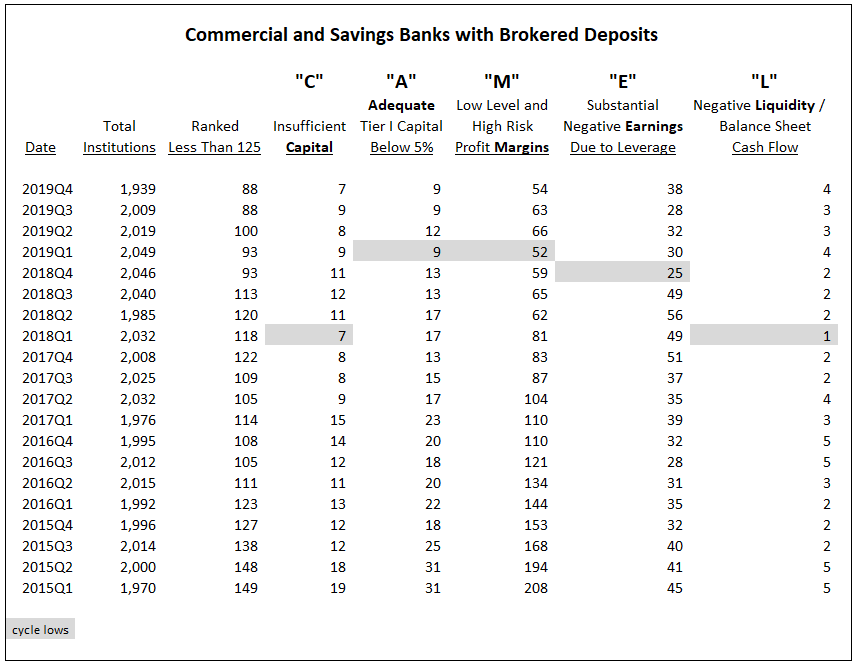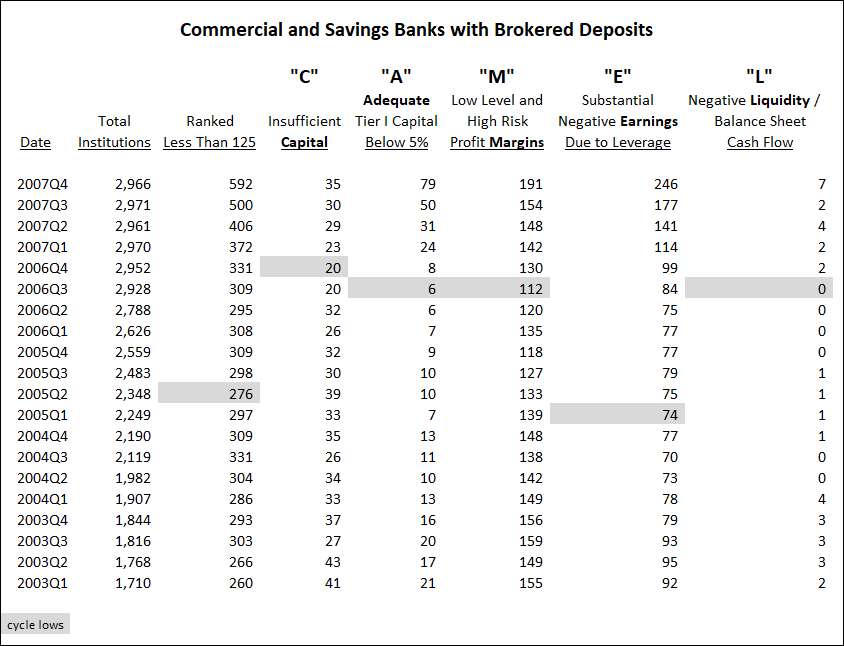Negative Balance Sheet Cash Flow Leads to Liquidity Risk
Liquidity risk occurs when an institution’s loan delinquency exceeds 4% of its total loans and its balance sheet cash flow is substantially negative. Balance sheet cash flow is operating cash flow minus financial cash flow.
Operating cash flow equals the annual change in retained earnings less the annual change in growth-producing fixed assets. The purpose of measuring operating cash flow is to determine an institution’s ability to finance the growth of fixed assets. Financial cash flow equals the annual change in liabilities and capital (excluding retained earnings) less the annual change in earning assets, such as loans, investments, and cash-equivalents.
The “L” in CAMEL
The “L” component in IDC Financial Publishing's (IDCFP) CAMEL rating represents institutions with negative liquidity and balance sheet cash flow. Large negative balance sheet cash flows occur if annual change in retained earnings is negative and/or the annual change in all other liabilities substantially exceeds the annual change in earning assets. An institution with poor loan quality or risky investments will experience asset write-offs or write-downs. At the same time, an at-risk institution will finance its asset base by relying on deposit increases and new borrowing. The resulting negative balance sheet cash flow threatens the safety and soundness of the financial institution.
Banks with significant negative balance sheet cash flow as a percent of equity capital, and loan delinquency in excess of 4% of all loans are given an IDCFP CAMEL rating below 125. The acronym CAMEL represents the financial ratios we use to evaluate the safety and soundness of commercial banks, savings institutions and credit unions. From the early 1990’s, through today, institutions using our safety ranks determined that ratings lower than 125 were deemed below investment grade. Our CAMEL ratings range from 300 (the top grade attainable) to 1 (the lowest).
Forecasting the Next Banking Crisis
Out of the 1,939 institutions with brokered deposits*, IDC Financial Publishing identified 88 ranked less than 125 in the fourth quarter of 2019, under our CAMEL component analysis (see Table I). This number is unchanged from the previous quarter. When we see the number of these poorly rated banks reach a low and begin to rise, it is one indication of the potential for a future crisis.
Covid-19 and a second quarter 2020 recession have created severe risk in the banking system. Reports on bank financial conditions to be released in May, for 2020Q1, and August, for 2020Q2, will detail this risk. Subscribe to IDC Financial Publishing’s online portal to receive updates.
As of 2019Q4, only the number of banks ranked below 125 with “substantial negative earnings due to leverage” and “negative liquidity” have risen, while the numbers under other CAMEL components are again in decline or remain unchanged (see Table I). An increase in the total number of commercial and savings banks ranked under 125 in a future quarter, as well as an advance in number of banks ranked below investment grade by each component of CAMEL, together would indicate a future banking problem.
Table I

A Specific Category of Banks Creates a Superior Forecast
At IDCFP, we focus on commercial and savings banks with brokered deposits as the best group of banks to analyze risk. Historically, institutions with brokered deposits* held most of all domestic liabilities and equity capital. This was the case in the years prior to the 2008-2009 banking crisis and remains the case today. This universe of banks is the best for statistical analysis and measure of potential financial crisis because of these characteristics:
- Control most of all domestic liabilities and capital, equal today to 91% of all bank holdings.
- High loan and deposit growth.
- Require brokered deposits over and above their core deposits to meet loan demand.
The remaining 3,294 banks are also ranked by IDCFP for safety and soundness; however, these smaller institutions present limited risk as a group to banking industry solvency.
In History: The Warning Signs Before a Financial Crisis
At-risk banks with brokered deposits began to rise in 2005. The number of banks with brokered deposits ranked less than 125 by IDCFP, or below investment grade, reached its low of 276 in the second quarter of 2005, then rose above that level, accelerating in late 2006 and through 2007. This rise in banks ranked below investment grade by IDCFP signaled the financial crisis with a 3-year lead time (see Table II).
Rise in at-risk banks with brokered deposits under each component of the CAMEL rank also began in 2005. Table II shows how each component of IDCFP’s CAMEL ranks reached cycle lows in the number of institutions ranked under 125 and subsequently rose to higher numbers well in advance of the financial crisis (see Table II).
- The earliest warning came from the E in CAMEL falling to 74 in the first quarter of 2005.
- In the third quarter of 2006, the A, M and L also reached lows.
- In the fourth quarter of 2006, the C in CAMEL reached its low 18 months before the financial crisis.
After reaching lows in number of at-risk banks, note that both the number of total banks and number by components of CAMEL subsequently accelerated through 2007.
Table II

As seen in history, the increase in the number of financial institutions with an IDCFP CAMEL rating below 125, or below investment grade, forecast the bank financial crisis, with the necessary lead time to take action. Our ranks are critical for investors to monitor financial institutions and prepare for potential risk.
*Brokered deposits exclude reciprocal deposits in this analysis due to changes in reporting requirements on reciprocals that distort history.
To view our products and services please visit our website at www.idcfp.com . For further information about our CAMEL ranks, or for a copy of this article, please contact us at 800-525-5457 or info@idcfp.com.
John E Rickmeier, CFA, President, jer@idcfp.com
Robin Rickmeier, Marketing Director
